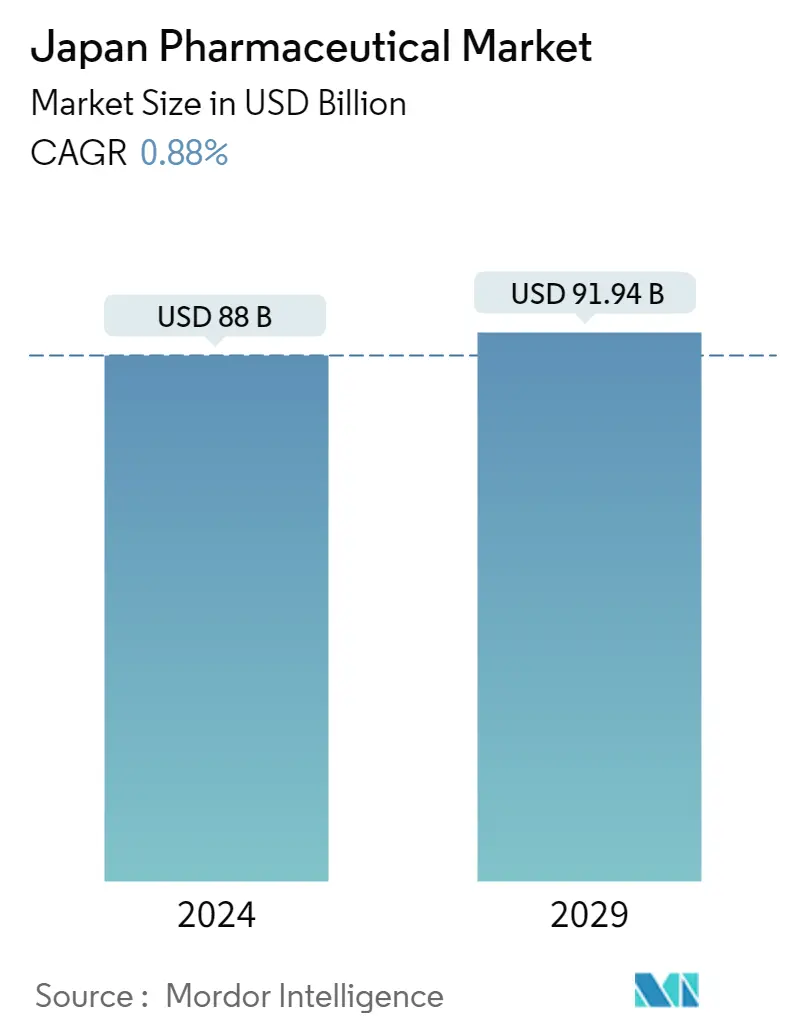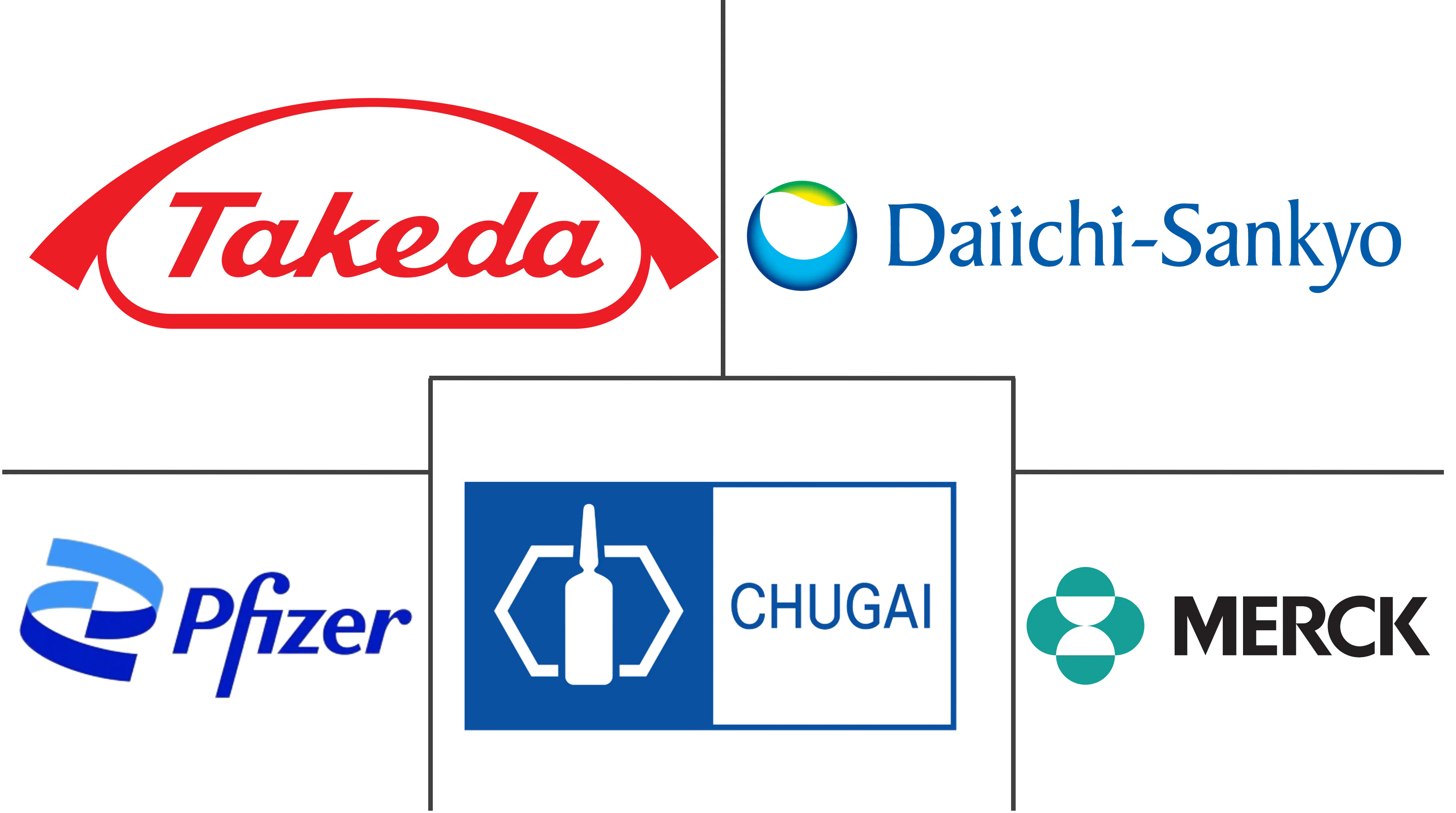Market Size of Japan Pharmaceutical Industry

| Study Period | 2019 - 2029 |
| Base Year For Estimation | 2023 |
| Forecast Data Period | 2024 - 2029 |
| Market Size (2024) | USD 88.00 Billion |
| Market Size (2029) | USD 91.94 Billion |
| CAGR (2024 - 2029) | 0.88 % |
Major Players
*Disclaimer: Major Players sorted in no particular order |
Need a report that reflects how COVID-19 has impacted this market and its growth?
Japan Pharmaceutical Market Analysis
The Japan Pharmaceutical Market size is estimated at USD 88 billion in 2024, and is expected to reach USD 91.94 billion by 2029, growing at a CAGR of 0.88% during the forecast period (2024-2029).
The COVID-19 pandemic significantly impacted the pharmaceutical market in Japan. The increased COVID-19 infection cases in the country increased the demand for prescription drugs and vaccines, which impacted the demand for pharmaceutical products. The increasing import of COVID-19 vaccines increased the demand for pharmaceutical products. For instance, in May 2021, the Japanese government signed a contract with Pfizer-BioNTech to import 194 million doses of vaccine by the end of 2021. The Japanese government granted emergency approval to COVID-19 vaccines and drugs, which impacted the market's growth. For instance, in May 2020, remdesivir was approved by the country to treat COVID-19 patients, while a vaccine was granted approval in February 2021. With the relaxation of pandemic-related restrictions and resuming company activities in manufacturing drugs and other products, the pharmaceutical market is expected to grow over the forecast period.
Factors such as the rising geriatric population, increasing incidence of chronic diseases, and growing research and development (R&D) investments in the country are boosting the market's growth in Japan.
The rising number of infections and chronic diseases such as cardiovascular diseases, diabetes, hypertension, cancer, neurological diseases, and others are driving the market's growth. According to the GLOBOCAN 2020 report, 1,028,658 new cancer cases were reported in Japan in 2020, and the total number of five-year prevalent cancer cases was 2,710,728. The same report projected the number of cancer cases to reach 1,110,549 by 2030 and 1,128,057 by 2040 in Japan. Thus, the expected increase in the number of people suffering from cancer is anticipated to increase the demand for effective drugs, boosting the market's growth.
An article published in May 2021 observed that 6.5 to 7 million people are expected to be living with dementia by 2025. About 8.5 to 11.5 million people in Japan are expected to have dementia by 2060. Thus, the expected increase in the number of people suffering from dementia is anticipated to increase the demand for drugs used to treat the disease. This is anticipated to fuel the market's growth during the forecast period.
The increasing geriatric population in the country is contributing to the market's growth. According to the 2022 statistics published by UNPF, 59% of the total population living in Japan is aged between 15-64 in 2022. As per the same source, 29% of the population is aged 65 years and above in 2022. Thus, the rising geriatric population is more prone to develop chronic diseases, such as cardiovascular diseases, neurological disorders, and cancer, raising the demand for effective therapeutics, which is expected to boost the market's growth.
The increasing focus on research and development activities and rising research and health expenditure in the country are expected to increase the development and availability of pharmaceutical products, bolstering the market's growth. For instance, as per 2021 statistics published by the OECD, Japan spent 3.27% of its GDP on its R&D activities in 2020.
In Japan, two crucial regulatory bodies review and approve drugs and medical devices: PMDA and MHLW. The regulatory committees engage in monitoring and surveillance to ensure the safety and efficacy of authorized biologics or pharmaceuticals in Japan. According to an article published in April 2021, the drug approval process in Japan is less complex and easy compared to some other countries. The PMDA and regulatory aspects offer consultation to sponsors to help them understand the requirements and the stepwise drug approval process. Hence, the number of companies is increasing in Japan, which is anticipated to increase the development of drugs, thereby propelling the market's growth.
The increasing investments and advances in the field of pharmaceuticals are increasing in the country. This is anticipated to drive market growth. For instance, in May 2022, ExoCoBio Inc. received a Japanese patent claiming that stem cell-derived exosome is an effective ingredient for alleviating dermatitis. The patent results from the vigorous R&D efforts to develop therapeutic medicines with higher efficacy and safety than currently known ones for dermatitis with itching and inflammation. Also, in March 2022, Japan launched a new research and development center for USD 1.6 billion to support the vaccine and drug projects as a part of a larger scheme to tackle infectious diseases. The establishment of an R&D facility for innovative partnerships and budget management will be under Supervisory Control And Data Acquisition (SCARDA). Thus, such developments are anticipated to drive market growth in Japan.
However, stringent regulatory scenarios for several products are expected to hinder the market's growth during the forecast period.
